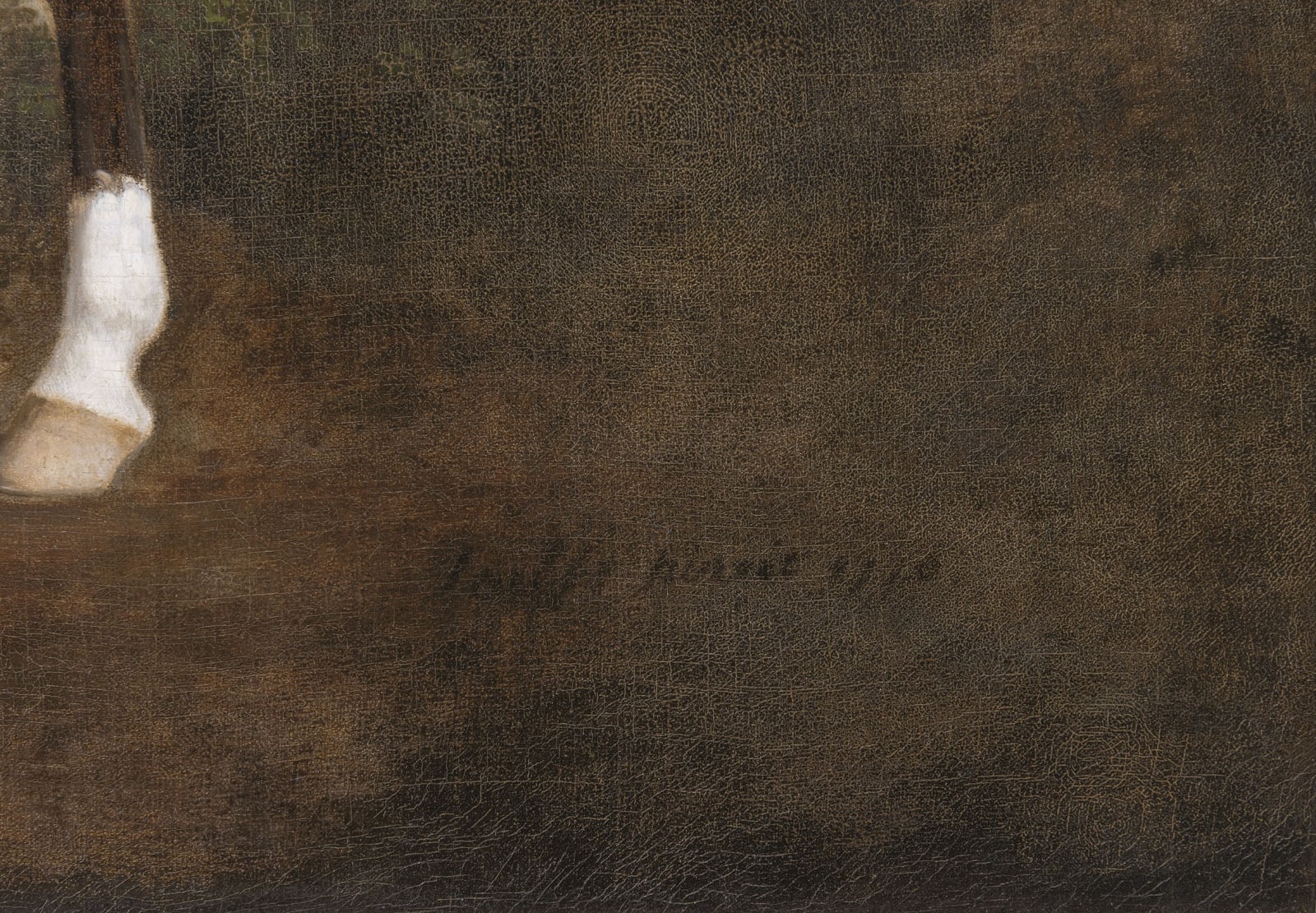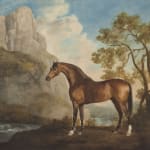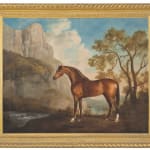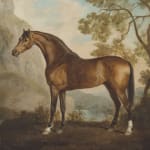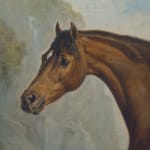George Stubbs, ARA British, 1724-1806
Further images
Provenance
Commissioned by Robert Gregory MP, of Valence, Kent, Rolls Park, Essex and Coole Park, Co. Galway, Ireland, 1775;
Sold as a pair, Fine Old Master Paintings and Drawings, Sotheby’s, London, 18 November 1959, lot 24, (bt. Leggatt Brothers, London, £19,000);
with Oscar and Peter Johnson, London, 1963;
Private collection, UK;
by descent, pair separated;
Private collection, pair reuinted.
Exhibitions
with Oscar and Peter Johnson, London, 1963, catalogue untraced, no. 6.Literature
J. Egerton, George Stubbs, Painter, Catalogue Raisonné, London, 2007, pp. 374-5, cat. no. 176, illustrated.
Engraved:
anon., entitled An Arabian horse belonging to MT Gregory, published by Sayer and Bennett 2 June 1777; L-B et al., 1989, nos. 23, 34; later reprinted.
These refined portraits, executed in 1775, were a pair of paintings commissioned by Robert Gregory MP (1727-1810): the grey Arabian and its pendant of a bay Arabian. Stubbs painted them at a time when he was firmly established as the leading painter of the day and it is not surprising therefore that these pictures are of such high quality, demonstrating Stubbs’ unequalled ability not only as an animal painter, but also as a painter of landscapes.
The magnificent Arabian stallion stands alone in a natural state, its stance is noble, with strong, alert eyes and its ears eagerly pricked. Stubbs’ uncompromising anatomical accuracy meant he could truly produce an individual portrait of a horse. He has captured the grey and bay’s precise form, their veins and muscles flexing beneath the surface of their silky skin. Stubbs’ delicate brushstrokes render not only the horse, but also the surrounding landscape in detail: the flowers at the horse’s feet and trees on top of the hill. The even fall of light across the stallion allows the eye to move round the composition through the diffused light of the crags and the stormy sky beyond, but always drawing the viewer’s gaze back to rest on the Arabian and its expressive features. The grey, green and brown tones of the rocky setting provide an excellent foil for pale brightness of the grey stallion’s coat, throwing it into sharp relief.
Stubbs was a master at representing the horses form, but he went further, his pursuit of anatomical accuracy was synthesized with a sense of empathy for the subject. The Arabian embodies a mystical form of animal power, both docile and uncontrollable. We know the horse is ‘tamed’ but in placing the stallion in this highly staged, rugged wilderness, we are encouraged to reflect on its wild origins, its majestic spirit, latent energy and its virility. Stubbs elevates the picture from a mere animal portrait to a large scale mythological scene or landscape painting.
Both the Grey Arabian and Gregory’s Bay Arabian, were said to have been bred by the "King of Sinnam in the mountains of Moses, in the province of Yamman in Arabia Felix" (King al-Abbas bin al-Husayn, al-Mahdi, of Yemen, reigned 1748-1775) and thence exported to India. From there they were sent to England in 1770 and by 1771 both horses were at stud at Robert Gregory’s Rolls Park estate in Essex. The Rycote Arabian, as Gregory’s Grey Arabian came to be known, was foaled circa 1761 and is around 14 years in the present picture. He does not appear in Weatherby’s General Stud Book. Gregory’s Grey went on to become successful bloodstock in English racing, being credited with two known offspring. The following advertisement appeared in Weatherby’s racing calendar in 1774, the Year before Stubbs’ portrait, p. 328:
‘The Fine Grey Arabian, upwards of 15 hands/ high, belonging to Mr Gregory, will cover mares at Chigwell, in/ Essex, at 10 gs each mare, and 5 s the groom.’
Willoughby Bertie (1740-1799), 4th Earl of Abingdon, subsequently bought the Grey Arabian from Mr Gregory, and sent him to stud at Rycote in Oxfordshire. The stallion was listed many times in Weatherby’s racing calendar cataloguing the various races that he ran.
Gregory’s Bay Arabian, was foaled circa 1763 and is around 13 years old in the present picture. Stubbs was commissioned to paint the work at a time of great success for the stallion. By this time he had become successful bloodstock in English racing, being credited with seven stud book offspring. He was said to stand at 14 hands 3 inches and in 1773, three years before this portrait was painted, he was reported as covering in Essex at Rolls Park, for a fee of 10 guineas (Wetherbys Racing Calendar 1774 p.328). He may later have covered for a season at Rycote and in 1778 he stood in Essex at Walthamstow. One of his daughters produced Lord Abingdon's stallion Je-Ne-Sais-Quoi who covered at Coton Hall.
The Arabian stallions’ owner, Robert Gregory, was an Irish-born East India merchant and a politician who sat in the House of Commons between 1768-1784, first as MP for Maidstone and then for Rochester, Kent. He went out to Bengal as a young man in around 1747, having joined the Honourable East India Company, and made his fortune there. On his return to Britain in 1766, Gregory settled in Kent, buying the estates of Valence, Kent, Rolls Park, Essex and Coole Park, in his native County Galway, Ireland. Gregory was three times Director for the Hon, East India Company between 1769 and 1782 and then Chairman briefly in 1782 before he stepped down, debilitated by ill health. Gregory effectively retired from public life in that year to the family seat at Coole Park, co. Galway, Ireland (B. Jenkins, Era of Emancipation, Quebec, 1988, p.59).
In her Catalogue Raisonné on Stubbs, Judy Egerton suggests it is likely the idea for Gregory to commission Stubbs to paint his imported Arabians came from the Marquess of Rockingham, one of Stubbs first and most significant patrons. Gregory gave evidence before the House in committee on East India affairs in 1767 and a year later was seeking a Parliamentary seat. On 4 March 1768 Rockingham wrote of him:
‘Mr. Gregory, a gentleman of good fortune, acquired really in a very honourable manner in the East Indies, and whose character and abilities I think well of,.... I shall try to do all the services I can for Mr Gregory, as I really like him from the conversations I have had with him on India matters and have found him very able and intelligent’ (ed. L. Namier and J. Brooke, The History of Parliament: the House of Commons 1754-1790, London, 1964, vol II, 1964, p. 307).
It was the Marquess of Rockingham who found Gregory his seat at Maidstone in 1768 and later at Rochester. Gregory remained loyal to the Rockingham faction during his political career, with Rockingham consulting Gregory on East India affairs.
During the decade prior to these portraits Stubbs had progressed from being a well established local artist in the north of England to becoming the leading animal painter in the country. This extraordinary transformation took place after Stubbs moved to London in 1758 and was brought to the notice of the Marquess of Rockingham and his fellow members of the newly founded Jockey Club. Rockingham commissioned no fewer than twelve pictures from Stubbs in the 1760s, most significantly the monumental Whistlejacket, now hanging in the National Gallery, London (NG6569).
Stubbs was born in Liverpool in 1724 the son of a currier. He was briefly apprenticed to a local artist where he remained for only a few weeks before leaving. He appears to have been largely self taught and practiced as a portrait painter in the north. At 26 he moved to York where he studied anatomy at York Hospital. His first professional job was to provide the illustrations for Dr John Burton’s Essay towards a Complete New System of Midwifery in 1751, attending the necessary dissection for those drawings.
In 1756, at the age of 32, he moved in the small hamlet of Horkstow, Lincolnshire, where he began working on a new project that would be critical in the development of his genius and in transforming his career. For two years he dissected and sketched horse carcasses. He devised his own tackle for hauling and maneuvering them so he could draw them in detail, stripping the skin and muscle, down to the skeleton. From these drawings and subsequent etchings that he made himself, Stubbs would produce his magnum opus, published in 1766, The Anatomy of the Horse. This unprecedented work would place Stubbs at the forefront of both science and art in his understanding of the equine anatomy, which has never been equalled.
In 1758 Stubbs moved to London, armed with his horse drawings, his arrival was well timed. As Basil Taylor, the 20th Century’s first serious Stubbs experts, wrote in his book Stubbs, p.12:
‘Not only field sports but the more informal conditions and pleasures of rural society had become so important in the life-style of the landed classes that the opportunity had emerged for the development of a distinctive iconography. The great era of country-house building was reaching its climax, and many foreign visitors to England in the eighteenth century were impressed by the attachment to country life they discovered here among the moneyed and sophisticated people. In the sixteenth and seventeenth centuries the portrait had uniquely served the interests of family, rank and ambition. A different form of art with a wider range of subject could confer a similar honour upon a whole scope of material property and the social returns it provided.’
There were horse painters before Stubbs, artists in the 17th century who created the genre of sporting painting, but Stubbs took it to a different level offering a new style quite beyond the abilities of his predecessors.
In his day Stubbs’ pictures commanded prices on a par with those of other leading artists, however he was not prolific. His highly technical pictures required time to paint them to his exacting standards. He painted around 400 paintings over his entire career and important works by the artist have only rarely appeared on the open market since then.
BIBLIOGRAPHY:
J. Egerton, George Stubbs, Painter, Catalogue Raisonné, London, 2007.
B. Jenkins, Era of Emancipation: British Government of Ireland 1812-1830, Quebec, 1988.
Weatherby’s Racing Calendar, 1774.
- Taylor, Stubbs, London, 1971.
ed. L. Namier and J. Brooke, The History of Parliament: the House of Commons 1754-1790, London, 1964, vol II.




